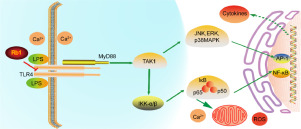当前位置:
X-MOL 学术
›
Phytomedicine
›
论文详情
Our official English website, www.x-mol.net, welcomes your
feedback! (Note: you will need to create a separate account there.)
Ginsenoside Rb1 exerts anti-inflammatory effects in vitro and in vivo by modulating toll-like receptor 4 dimerization and NF-kB/MAPKs signaling pathways.
Phytomedicine ( IF 6.7 ) Pub Date : 2020-02-26 , DOI: 10.1016/j.phymed.2020.153197 Hongwei Gao 1 , Naixin Kang 2 , Chao Hu 2 , Ziyu Zhang 2 , Qiongming Xu 2 , Yanli Liu 2 , Shilin Yang 1
Phytomedicine ( IF 6.7 ) Pub Date : 2020-02-26 , DOI: 10.1016/j.phymed.2020.153197 Hongwei Gao 1 , Naixin Kang 2 , Chao Hu 2 , Ziyu Zhang 2 , Qiongming Xu 2 , Yanli Liu 2 , Shilin Yang 1
Affiliation

|
BACKGOUND
Ginsenoside Rb1, the main active constituent of Panax ginseng, displays significant anti-inflammatory activity, although the mechanism has not been clearly unraveled. In this study, Rb1's mechanism of anti-inflammatory effects were investigated.
METHODS
The flow cytometry and enzyme-linked immunosorbent assay (ELISA) were empolyed to detect pro-inflammatory cytokines release. The related protein and gene expression was investigated by western blotting and qRT-PCR. The dimerization of TLR4 was measured by co-immunoprecipitation and molecular docking assays. Cellular thermal shift assay was used for the determination of the binding of Rb1 and TLR4. For animal moldels, LPS- or cantharidin-induced acute kidney injury, LPS-induced septic death, and dimethyl benzene-induced ear edema were employed to investigate Rb1's anti-inflammatory activity in vivo.
RESULTS
Rb1 significantly decreased inflammatory cytokines release in LPS-stimulated RAW264.7 cells and BMDMs, as well as COX-2 and iNOS amounts. Rb1 reduced LPS-associated calcium influx, ROS production, and NO generation. The NF-κB and MAPK axes participated in Rb1's anti-inflammatory effects. Molecular docking simulation indicated Rb1 bound to TLR4 to prevent TLR4 dimerization, as confirmed by co-immunoprecipitation and cellular thermal shift assay. Furthermore, MyD88 recruitment and TAK1 expression were altered by reduced TLR4 dimerization, indicating the TLR4-MyD88-NF-κB/MAPK pathways contributed to Rb1's anti-inflammatory process. In animal models, Rb1 markedly alleviated LPS- or cantharidin-induced acute kidney injury, rescued LPS-induced septic mice from death, and inhibited dimethyl benzene-induced mouse ear edema.
CONCLUSION
Overall, these findings demonstrate Rb1 exhibits marked anti-inflammatory effects, suggesting Rb1 represents an optimal molecule for treating inflammatory diseases.
中文翻译:

Ginsenoside Rb1 通过调节 toll 样受体 4 二聚化和 NF-kB/MAPKs 信号通路在体外和体内发挥抗炎作用。
背景人参皂甙 Rb1 是人参的主要活性成分,具有显着的抗炎活性,但其机制尚未明确。在这项研究中,研究了 Rb1 的抗炎作用机制。方法采用流式细胞仪和酶联免疫吸附试验(ELISA)检测促炎细胞因子的释放。通过蛋白质印迹和qRT-PCR研究相关蛋白质和基因表达。TLR4的二聚化通过免疫共沉淀和分子对接测定来测量。细胞热位移测定用于测定 Rb1 和 TLR4 的结合。对于动物模型,使用 LPS 或斑蝥素诱导的急性肾损伤、LPS 诱导的败血性死亡和二甲苯诱导的耳水肿来研究 Rb1' s 体内抗炎活性。结果 Rb1 显着降低 LPS 刺激的 RAW264.7 细胞和 BMDM 中炎性细胞因子的释放,以及 COX-2 和 iNOS 的量。Rb1 减少了与 LPS 相关的钙内流、活性氧的产生和一氧化氮的产生。NF-κB 和 MAPK 轴参与了 Rb1 的抗炎作用。分子对接模拟表明 Rb1 与 TLR4 结合以防止 TLR4 二聚化,这已通过免疫共沉淀和细胞热转移试验证实。此外,MyD88 募集和 TAK1 表达因 TLR4 二聚化减少而改变,表明 TLR4-MyD88-NF-κB/MAPK 通路有助于 Rb1 的抗炎过程。在动物模型中,Rb1 显着减轻 LPS 或斑蝥素诱导的急性肾损伤,使 LPS 诱导的脓毒症小鼠免于死亡,并抑制二甲苯引起的小鼠耳水肿。结论 总体而言,这些发现表明 Rb1 表现出显着的抗炎作用,表明 Rb1 是治疗炎症性疾病的最佳分子。
更新日期:2020-02-26
中文翻译:

Ginsenoside Rb1 通过调节 toll 样受体 4 二聚化和 NF-kB/MAPKs 信号通路在体外和体内发挥抗炎作用。
背景人参皂甙 Rb1 是人参的主要活性成分,具有显着的抗炎活性,但其机制尚未明确。在这项研究中,研究了 Rb1 的抗炎作用机制。方法采用流式细胞仪和酶联免疫吸附试验(ELISA)检测促炎细胞因子的释放。通过蛋白质印迹和qRT-PCR研究相关蛋白质和基因表达。TLR4的二聚化通过免疫共沉淀和分子对接测定来测量。细胞热位移测定用于测定 Rb1 和 TLR4 的结合。对于动物模型,使用 LPS 或斑蝥素诱导的急性肾损伤、LPS 诱导的败血性死亡和二甲苯诱导的耳水肿来研究 Rb1' s 体内抗炎活性。结果 Rb1 显着降低 LPS 刺激的 RAW264.7 细胞和 BMDM 中炎性细胞因子的释放,以及 COX-2 和 iNOS 的量。Rb1 减少了与 LPS 相关的钙内流、活性氧的产生和一氧化氮的产生。NF-κB 和 MAPK 轴参与了 Rb1 的抗炎作用。分子对接模拟表明 Rb1 与 TLR4 结合以防止 TLR4 二聚化,这已通过免疫共沉淀和细胞热转移试验证实。此外,MyD88 募集和 TAK1 表达因 TLR4 二聚化减少而改变,表明 TLR4-MyD88-NF-κB/MAPK 通路有助于 Rb1 的抗炎过程。在动物模型中,Rb1 显着减轻 LPS 或斑蝥素诱导的急性肾损伤,使 LPS 诱导的脓毒症小鼠免于死亡,并抑制二甲苯引起的小鼠耳水肿。结论 总体而言,这些发现表明 Rb1 表现出显着的抗炎作用,表明 Rb1 是治疗炎症性疾病的最佳分子。









































 京公网安备 11010802027423号
京公网安备 11010802027423号